We’re already to the money-making part, and it’s only step 4!
Obviously, there’s a lot to do between publishing your first website and actually making money, but it’s still pretty cool to see that making money with affiliate marketing isn’t really that hard.
- Pick A Topic
- Build A Website
- Publish Articles
- Add Affiliate Links (YOU ARE HERE)
Right now I’m going to show you how to join affiliate programs, get your affiliate links, and add them to your website. It’s pretty straightforward.
But wait.
If affiliate marketing is so easy, why are so few people successful?
Step #3 prevents a lot of people from reaching their true potential. I’ll talk more about success at the bottom of this page, and in future content, but the main thing that stops fresh affiliates from actually making money is (lack of) traffic to their websites.
They don’t publish enough content, so they don’t get traffic.
Without traffic, you can’t get clicks to your affiliate links.
You can have an amazing affiliate website, with original content, beautiful visuals – the works. But if you only publish five articles, they won’t have the authority to rank in search engines. You may get a trick of traffic here or there, but not the numbers needed to see true income.
So if you are landing on this page, psyched to start joining affiliate programs, take a step back first.
- How many articles do you have published so far?
- Are you writing 1200 words per article?
- Are you getting traffic yet?
If the answer is, “No”, then maybe you aren’t ready to join affiliate programs yet. This is a marathon, not a sprint. You can place 100 affiliate links on two blog posts, but they won’t make any money if you don’t have traffic yet. Be realistic.
Don’t stress out about being too perfect though. Affiliate programs are relatively easy to join, and most will accept you, even with a brand new website! Rejection does happen, but you can always reapply later.

Making Money With Affiliate Programs!
- What Makes A Good Affiliate Program?
- Examples of Affiliate Programs
- Example #1
- Example #2
- Example #3
- Amazon Associates
- How to Find Your Affiliate Link
- Raw Links VS HTML Code
- Deep Linking
- Tracking Codes
- How To Make A Link In WordPress
- Classic Editor
- Gutenberg Editor
- Where To Place Affiliate Links For Results
What Makes A Good Affiliate Program?
There are thousands of affiliate programs to choose from. Even within a single industry, you’ll have plenty of options.
So how do you know which one is the best to promote? The answer is subjective.
Whatever product is most relevant to your audience, or to a specific piece of content is the best one to promote. That relevancy is key.
If your website is about antivirus software reviews, but you have an article about cryptocurrency hardware wallets, should you promote an antivirus software or a crypto wallet?
A crypto wallet is the correct answer, because it’s relevant to the content the person is reading.
In other words, there is never going to be a “best” affiliate program to promote. There are many variables to consider, including your humble opinion!
However, it’s a lot of work setting up content and campaigns to promote affiliate products. That means you should do a bit of due diligence before going too gung-ho with your affiliate links.
After working in the affiliate space for a decade now, there are some criteria I look for.
- Commission percentage & dollar amount
- Quality of products & services
- How long the affiliate program has been around
- Affiliate manager available for support & questions
- EPC* or similar metric
None of these are “must have”. I’ve done with with absent affiliate managers. My favorite story is how I built $1,000 passive income from a $1.15 (that’s very low!) commission product.
You can make a large amount of money from affiliate commissions no matter what you promote. These are just guidelines I use to make sure I’m leveraging my time best to promote products that get me paid for my work.
*EPC means Earnings Per Click and is used as a metric to show generally how much affiliates earn for their effort. It’s a conversion rate to show how well the product converts customers from clicks to sales.
That means a product with a $1 EPC is not converting as well as a product with $2 EPC. That means the latter one has a more engaging sales page or better product, and more people buy it compared to the other one.
Examples of Affiliate Programs
There’s just no way to introduce to you all of the affiliate programs out there. That’s why I’m publishing individual lists of good affiliate programs based on specific topics.
The programs I’m going to show you right now probably won’t fit your niche (with one exception). Let’s just look at them so you can see what’s available, and start to get your bearings.
Example Affiliate Program #1: Blue Apron

Blue Apron is the original meal kit delivery service. They run their affiliate program through an affiliate network called Impact. This affiliate network also represents some other famous brands like Bark Box and Harry’s, so it’s a great network to get affiliated with.
Impact houses hundreds of other affiliate programs as well, so once you create an account there, you can start exploring the marketplace to get more ideas of what products you want to promote.
Blue Apron pays $15 per sale, which is a pretty good commission IMO. They are a recurring service, so they want to pay affiliates a lot of money for that customer acquisition.
Example Affiliate Program #2: HideMyAss
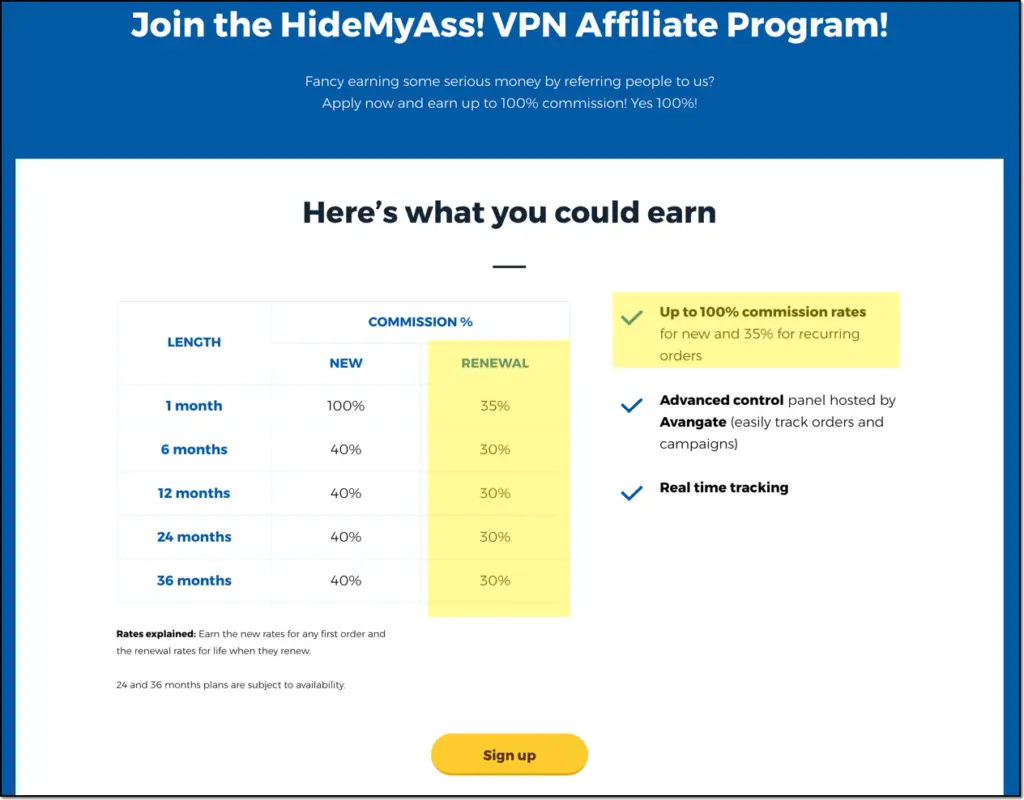
HideMyAss is a VPN service with a funny name, but some serious payout stats. They pay 100% commissions on 1-month subscriptions! (They can do this because this is a recurring service, and they want that initial customer acquisition real bad).
What’s even cooler is that they also pay recurring commissions to affiliates. That means if a customer stays on for two years, you get paid for two years, every damn month.
This type of setup makes it super easy to snowball commissions and get your affiliate income to go parabolic. 30% of a $20 product isn’t much, but it adds up.
Example Affiliate Program #3: Turnkey Vacation Rentals
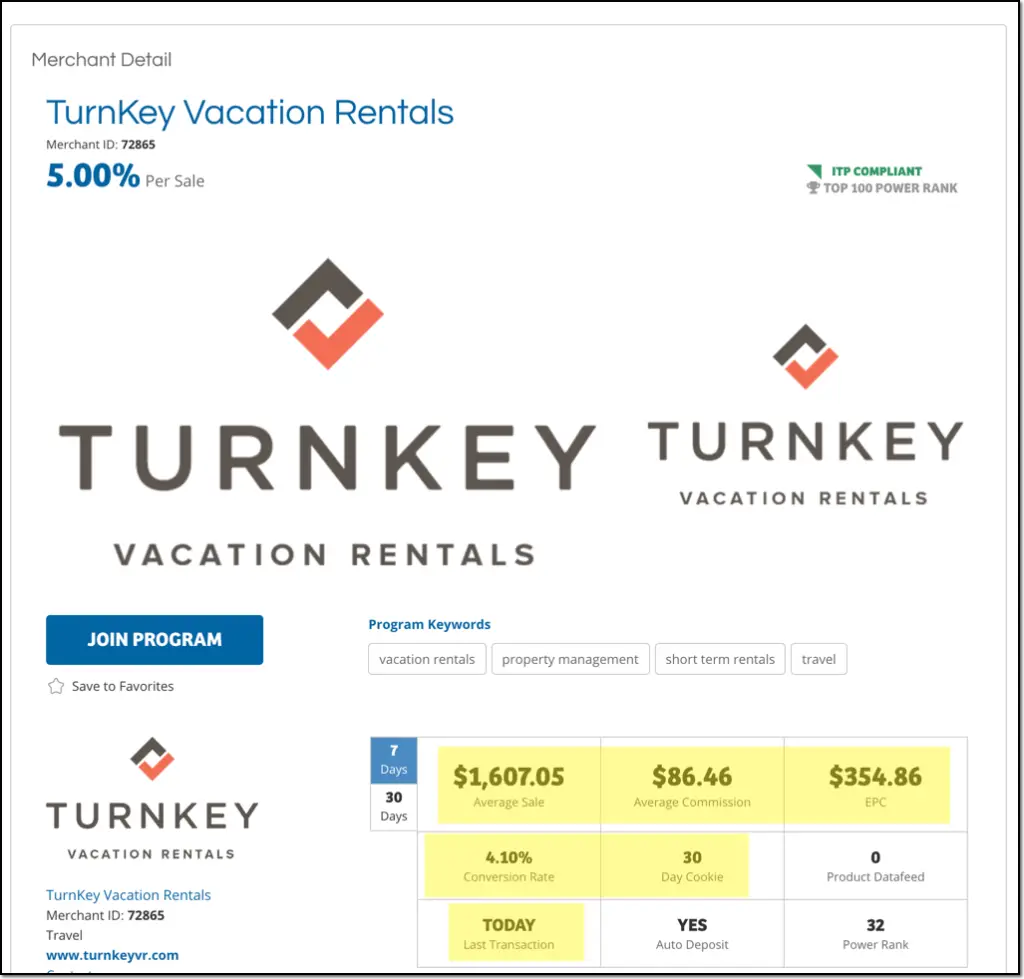
There are a huge variety of affiliate products out there. This one called Turnkey Vacation Rentals targets home owners that want to turn their properties into luxury vacation spots.
Well, if you have a vacation property, you probably have money to spend. That’s why this company can charge a lot of money to manage those properties.
What that means for you is if you help Turnkey acquire a new customer, you get paid a lot too! With an astronomical EPC of $354, an average payout of $86 per sale, and the last transaction happening today, this is a stellar affiliate program.
Don’t feel like you have have to join this one though. It’s just one example, and there are many more out there with products that are more relevant to your niche.
This company runs their affiliate program through Shareasale, another trusted affiliate network.
Amazon Associates
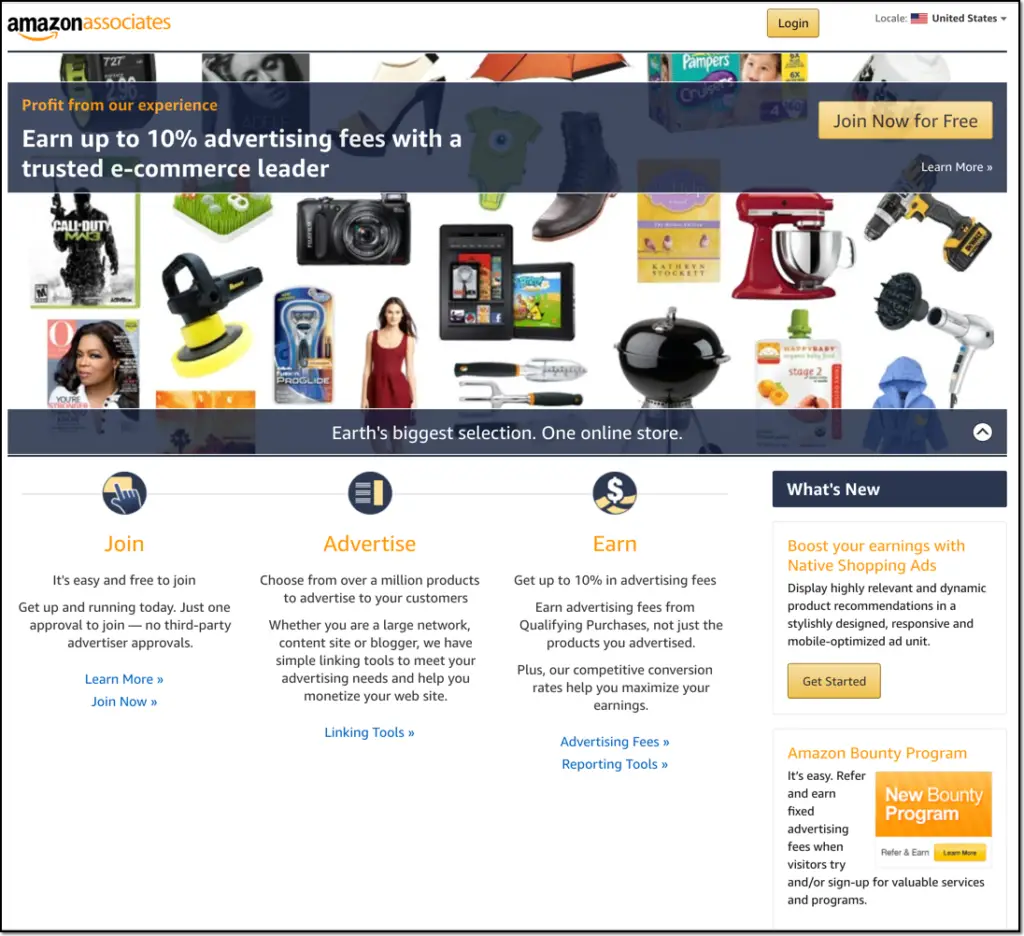
Perhaps the most famous affiliate program out there, Amazon Associates is a global favorite for earning affiliate commissions.
This is both a famous, and infamous affiliate program. Some people love it, some hate it.
The great thing about Amazon Associates is that it’s super easy to get into, and you have the biggest range of products available, anywhere in the entire world. They have something for every single niche you can think of.
The downside is that the percentage commissions is very low in comparison to some other companies. 4% to 10% is what they pay, with most categories falling in the 4-5% range.
Plus, they’re a huge, faceless company, and tend to not have very good support for affiliates.
It’s a great affiliate program to join, but I wouldn’t put all my eggs in this one basket.
How to Find Your Affiliate Link
Each affiliate program is different, so I can’t cover all the way to find or create your affiliate links. What I do want to do is cover a few common things to look out for, and those broad concepts can help you navigate.
Raw Links VS HTML Code
With affiliate networks like Shareasale, Commission Junction (CJ), Rakuten, Flexoffers, Impact, and Awin, you’ll have a choice whether to pick your raw affiliate links, or a pre-made HTML code. This is pretty confusing to newbies!
What you want to look out for is the raw affiliate link. This is the link you need people to click.
The HTML code is just a pre-packaged clickable link you can paste into your site, but it doesn’t allow you to customizing the “anchor text”, which is the words people click. Here’s a perfect example from CJ.
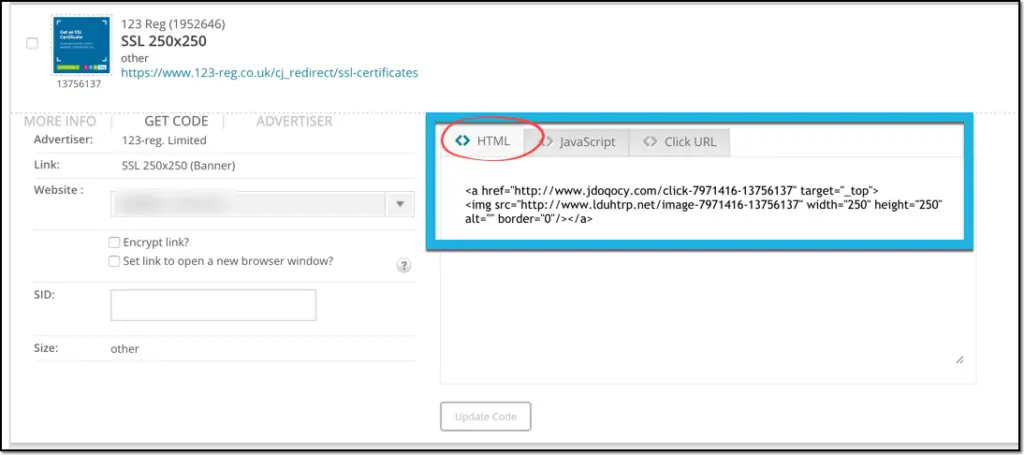
There’s no way newbies are going to understand what that means. Basically, it’s a mess of code you can paste directly into your site so it makes a clickable affiliate link. That’s not what we want.
In this case, we need the “Click URL”.


See how the URL starts with http and ends without a quote (“”) or an angle bracket (<>)? That’s our raw affiliate link. We can use that to create a custom link in WordPress (see below).
Deep Linking
With a good affiliate program, you’ll be able to send your traffic to any page on the vendor website – not just the home page. “Deep Linking” refers to linking to pages deeper in the website.
This is important because it helps with the flow of relevancy. In the image below, I’m linking directly to the pricing plan of WPEngine, a website hosting service. This may be a good alternative to linking to the home page, where a person could get bored or lost, and then close the window.
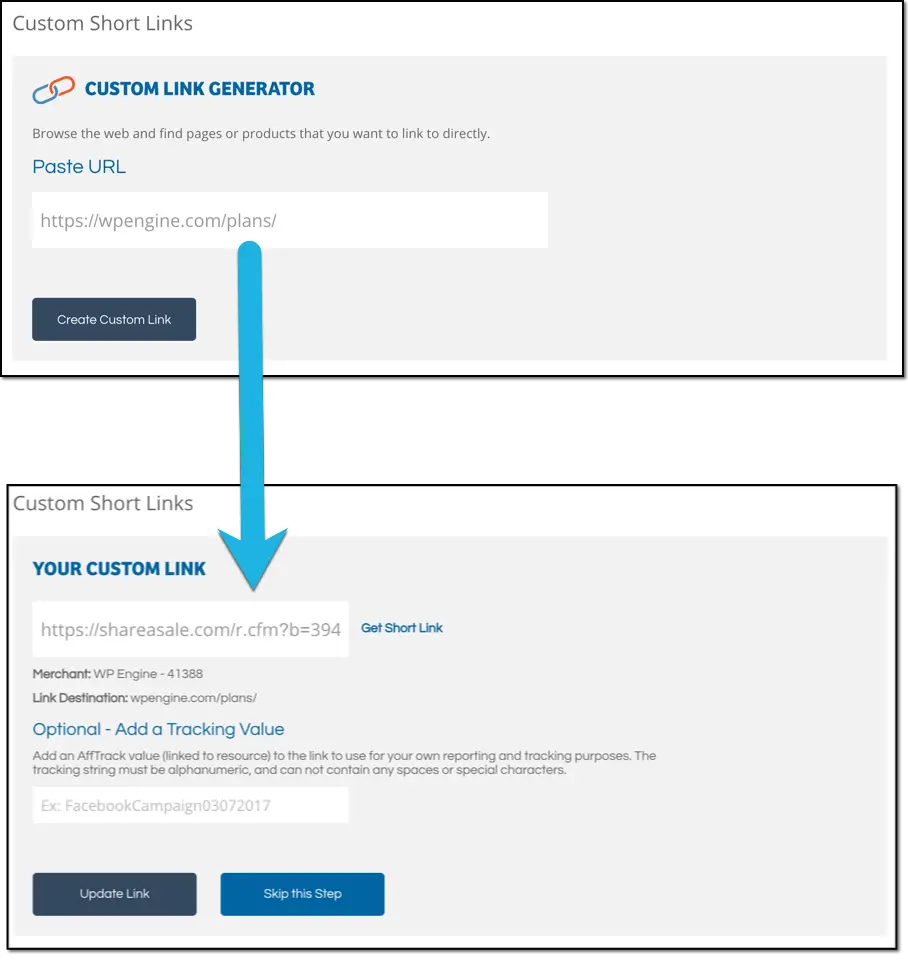
Tracking Codes
To be honest, you don’t really need this right now, but tracking codes will come in handy later. When you start generating loads of traffic and clicks, you’ll want to know what your most effective links are, so you can focus on optimizing them, or know what your worst performing links are, so you can troubleshoot.
If all your links are exactly the same, finding the best and worst performers is just guesswork.
With tracking codes, you can immediately know which links are getting the most clicks and sales. Impact makes inserting tracking codes into your affiliate links super easy.
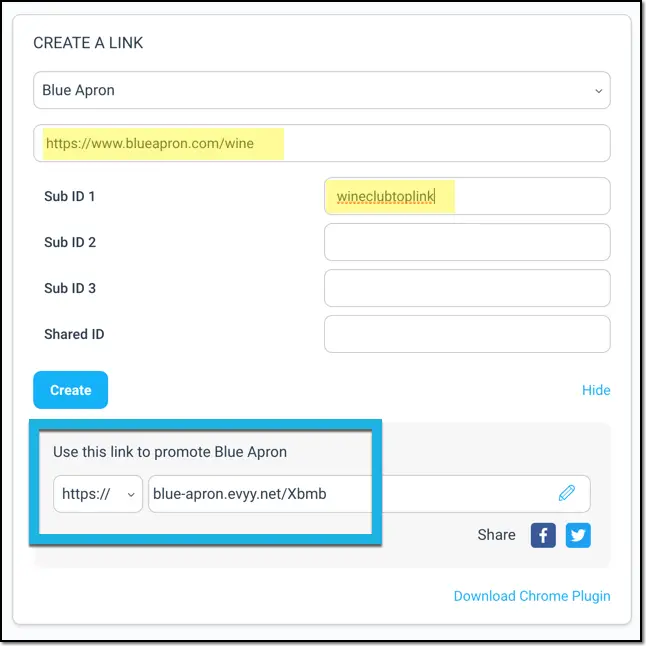
In the example above, if this link generates sales, I’ll know that the link to the wine club I placed at the top of my review page is effective.
How To Make A Link In WordPress
Right now is a confusing time for WordPress. They just upgraded the editor to something called “Gutenberg”, which is the biggest change to the WordPress platform in a decade.
Unfortunately, everyone was used to the Classic Editor, so everyone is pissed. I guess we’ll get over it though.
Classic Editor Links
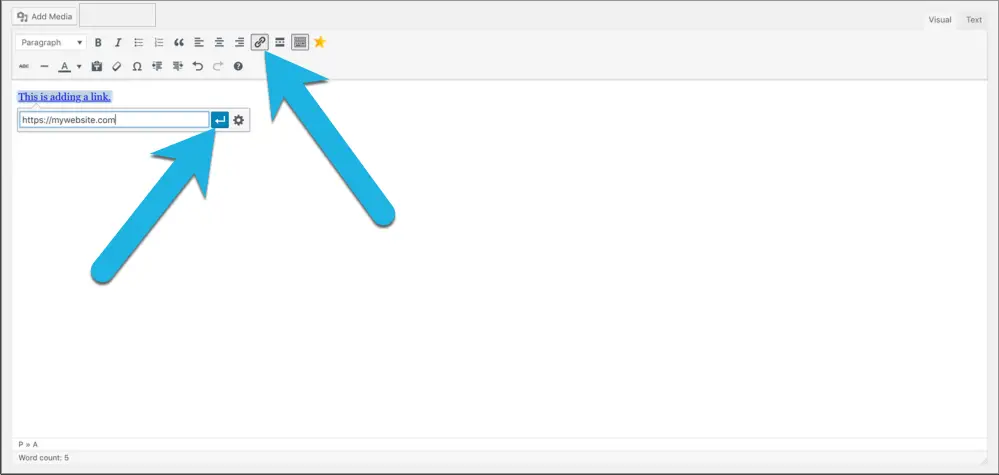
To create a link in the Classic Editor, highlight the text you want to be clickable. Then click the “link” button in your text editor, and paste your affiliate link into the box.
Click the arrow, and your link is now live!
Gutenberg Editor Links
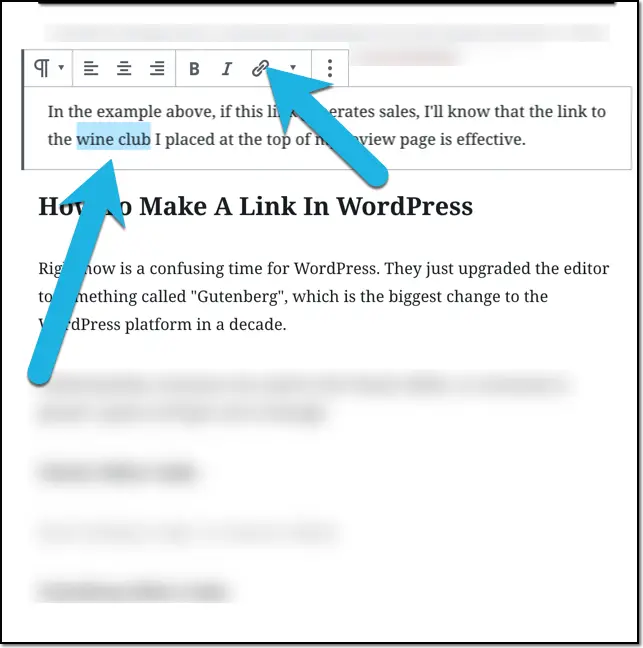

Where To Place Affiliate Links For Results
There’s no one, perfect way to earn money from affiliate links. Some people are super casual, and just place a “buy now” link at the end of the page.
Other websites are pretty aggressive, and you’ll see affiliate links all over!
So what’s the best strategy?
Well, you have to experiment and find out. Everyone’s personality and vision for their business is different too, so do what feels comfortable for you.
As a general rule of thumb, I like to place an affiliate link in the top, early middle, and bottom of the page. Most clicks happen near the top of the page because everyone is impatient online. However, the highest conversions will come at the bottom link, because those are the serious readers and informed buyers.
How Many Affiliate Links Per Page?
There’s no rule about how many affiliate links to place on a page. I have some pages which have ranked in the top 3 spots on page 1 of Google with 10-20 affiliate links!
I also have plenty of pages with zero affiliate links that don’t rank at all.
The main thing to keep in mind is user experience, and value to the reader. Does the affiliate link you want add to the article help the reader, or just help you make money?
A link at the top of the page when you introduce the product for a product review article could be super helpful to an impatient reader. Who really has time to read all this junk when you just want to know if the thing is good or bad and get down to business!
Making money from your website is not a crime, and Google will not punish you for having affilaite links.
But are five affiliate links at the bottom of the page really necessary? You aren’t going to trick anyone into buying something they don’t want. Start with just one, and if you see a lot of traffic coming to the page, use your link tracking to experiment.
Final Thoughts
Now that you’ve completed these four lessons, what steps are missing? I’m building out this website to be as helpful as possible to anyone learning affiliate marketing, so let me know what you need.
As an affiliate marketer in the biz for 10 years, it’s easy for me to forget what it was like being a newbie!
Leave a comment and I’ll get back to you ASAP.